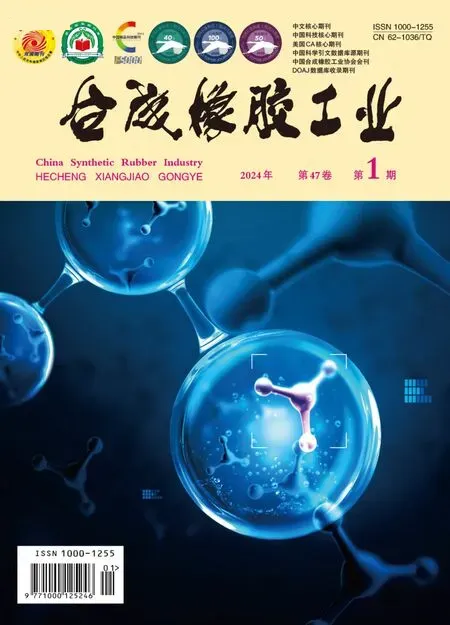Synthesis of carboxyl-terminated liquid nitrile-butadiene-butylacrylate rubber and mechanical properties of toughening epoxy resin
TONG Shao-kai, YUE Yan-fang, FENG Zhan-wei, HE Jian-yun*, FAN Wei-feng*
(1. Changqing Downhole Technology Company, CNPC Chuanqing Drilling Engineering Co Ltd, Xi′an 710018, China; 2. Key Laboratory of High-Performance Synthetic Rubber and Its Composite Materials/Changchun Institute of Applied Chemistry, Chinese Academy of Sciences, Changchun 130022, China)
Carboxyl-terminated liquid nitrile rubber (CTBN)has been extensively studied for toughening modification of epoxy resin due to its good compatibility and telechelic polymer nature,allowing the carboxyl groups to react with the epoxy groups[1-2].Carboxyl -terminated liquid nitrile -butadiene -butylacrylate rubber (CTBNB)is a modified variety of CTBN,and its flexible ester functional groups can act as plasticizers and improve the low-temperature and heat resistance of polymer chains.
In this study,we first report the synthesis of CTBNB and its toughening modification on E 51 epoxy resin.The emulsifier used in the polymerization process was a combination of potassium abietate and sodium dodecyl sulfate,with a mass ratio of 3/3/3/1 for butadiene, acrylonitrile, butyl acrylate and methyl methacrylate monomers.CTBNB was prepared through quaternary copolymerization.As shown in Fig 1,compared to nitrilebutadiene-butylacrylate rubber (BNBR), CTBNB exhibits a characteristic peak of methyl methacrylate at chemical shift 1.1 by1H-NMR,with a calculated carboxyl mole fraction of 3.6%.Additionally, in the FTIR of CTBNB in Fig 2, apart from the characteristic peaks of nitrile and ester groups, there is a distinct carboxyl hydrogen peak at 3 300 cm-1.These findings indicate the successful preparation of CTBNB.

Fig 2 FTIR spectra of CTBNB and BNBR
The synthesized CTBNB was subsequently blended with E 51 epoxy resin at varying amounts of 0, 10, 15 phr respectively,followed by pre-polymerization at 100 ℃.After cooling, the curing agent methylhexahydrophthalic anhydride and curing catalyst tris(dimethylaminomethyl) phenol were introduced.Vacuum degassing was performed prior to casting the mixture into a mold for subsequent curing at 160 ℃.The mechanical properties are presented as Table 1.The addition of 10 phr CTBNB significantly enhances the tensile strength, elongation at break and impact strength of the composite material.Furthermore, with a higher concentration of 15 phr CTBNB, the impact strength reaches an impressive value of 30.11 kJ/m2,representing a remarkable increase of 259% compared to its original value.This can be attributed to the presence of flexible ester groups that act as plasticizers and rubber particles that disperse and absorb significant amounts of energy during deformation,thereby improving the toughness of the resin.

Table 1 Mechanical properties of epoxy resin modified by CTBNB

